Kerala has rich culture and heritage which is so well preserved by the locals. The unique beauty of Kerala is not only reflected in its glistening water bodies and verdant forests but also in its vivid culture, vibrant art, soulful music, and several impressive Kerala dance forms.
These radiant Kerala dance forms are what local Malayali people use to live their love for dance, drama, and storytelling and portray the beauty of their land in events and festivals! Along with Carnatic and classical music, the performances of dances in Kerala make you swoon and leave you in awe of the performers.
Traditional dance forms in Kerala give you a chance to experience the culture of Kerala that will surely steal your heart. The surreal experience of witnessing a dance form in Kerala is equivalent to gazing at its pristine backwaters from a houseboat cruise.
There are more than fifty well-known Kerala traditional dances. Out of those fifty dance forms, Kathakali is said to be the most popular folk dance in Kerala. The folk dance of God’s Own Country is filled with attractive colors and vivid costumes combined with elegant body movements and traditional music.
ALSO SEE – 75 Best Things To Do In Kerala
Dance is an integral part of Kerala’s art and culture and no festival is complete without a brilliant showcase of the Kathakali dance. These dance forms have gained popularity not only in the state but also across the globe! Each dance form is unique and has a different way of expression adorned with ornaments, bright costumes, and makeup.
10 Most Enchanting Kerala Dance Forms You Must Witness
Let’s find out some of the best traditional dance forms in Kerala that will leave you awestruck on your trip to Kerala!
1. Kathakali
Not only is Kathakali amongst the most famous dance forms in Kerala but has started gaining recognition across the world as well. It is performed by artists on various auspicious occasions and religious events.
Kathakali originated about 500 years ago in Kerala and uses a combination of music, art, and design as a form of expression to give you a spectacular theatrical performance. Kathakali, one of the most famous Kerala dance forms, is usually performed by men with colorful attire to portray characters from the Ramayana, the Mahabharata, and the Puranas.
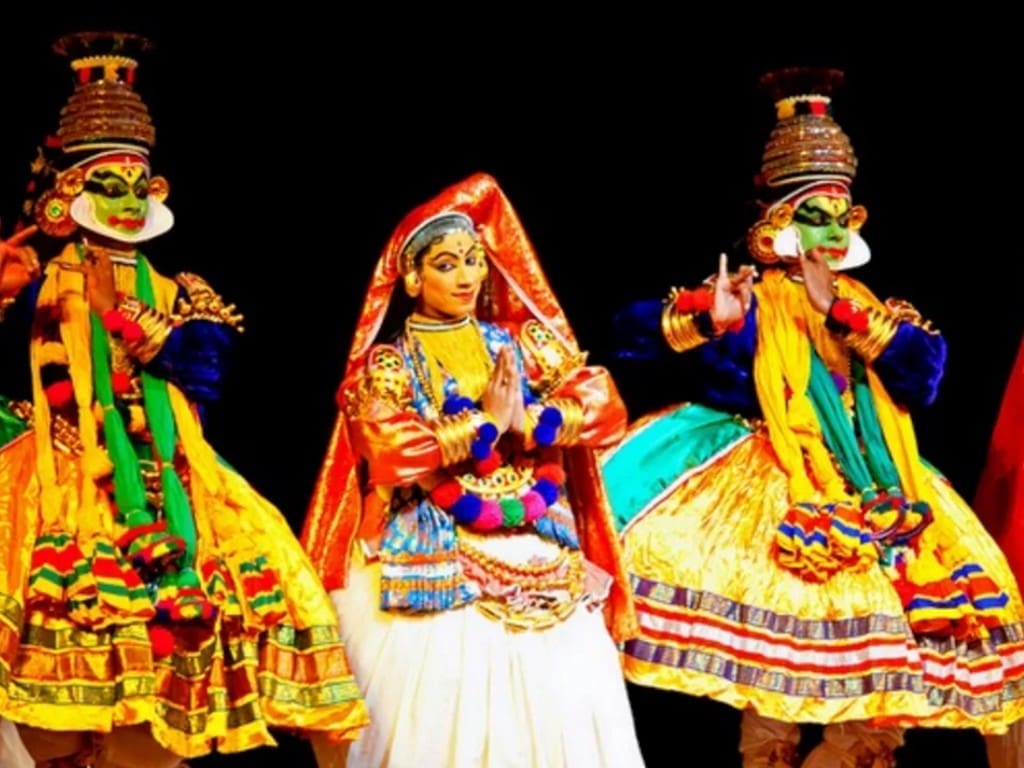
Kathakali is usually performed by men with colorful attire and face paint to depict tales of ancient epics and legends. Kathakali is a form of ballet with muscle movement and eye movement to express emotions concerning the life of Lord Krishna.
Where to watch Kathakali in Kerala:
- Kerala Kalamandalam, Thrissur
- Kerala Kathakali Center, Kochi
- Folklore Museum, Kochi
Kathakali dancers are usually decked up in billowing skirts, headgear, ornaments, and their faces are painted in colors of green, white, and red to portray different characters.
ALSO SEE – Best Places To Watch Kathakali In Kerala
2. Mohiniyattam
Mohiniyattam is a very elegant and fluid form of dance that is performed by women and it involves lots of eye movement and graceful movements that enchant audiences! The Mohiniyattam dance is the most famous classical dance form in Kerala. It has the combined elements of two other dance forms, the Bharatanatyam and Kathakali.

The dance gets its name from the word Mohini, which is the name given to the female enchantress avatar of Lord Vishnu, the Hindu deity, who had helped devas claim victory over asuras employing her graceful moves and feminine charm. It is performed individually by solo female dancers.
When it is done in a group, it is a beautiful amalgamation of perfect coordination and visually stunning moves. This popular Kerala dance form originated in the 16th century and is said to have been performed by devadasis dancing on classical music with very fragile and sensuous movements.
Where to watch Mohiniyattam in Kerala:
- Kerala Kalamandalam, Thrissur
- Rhythms Theatre, Kochi
- Margi Theatre, Trivandrum
ALSO SEE- Top 15 Places To Visit In Kerala In 2024 (With Map)
3. Thiruvathirakkali
A popular dance form in Kerala that is often performed by a group of women in a circular movement during the harvest festival of Onam. It is performed by women to attain everlasting marital bliss. It is usually performed from December to January in the Malayalam month of Dhanu in honor of Lord Shiva.
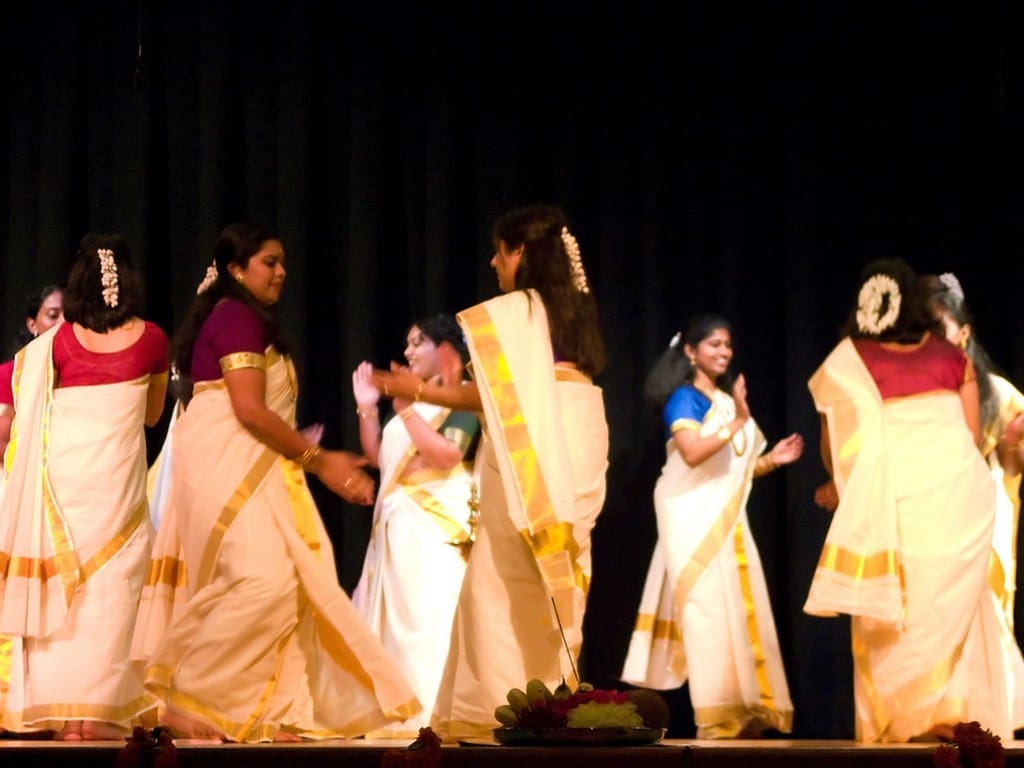
Also called Kaikottikali, this dance form is performed in a circular pattern along with clapping and singing around a traditional wick lamp, called a Nilavilakku, or floral decoration.
Where to watch Thirvathirakali in Kerala:
- In Shiva temples across Kerala during Onam celebration
Thiruvathirakkali dance form signifies the power of women, their charm, and grace
ALSO SEE – Pulikali – Tiger Dance in Kerala
4. Kolkali
Kolkali is a particular dance form that involves 24 performers of the farming community. It is usually performed using wooden sticks where dancers move along in circles tapping the wooden sticks that are two feet long.
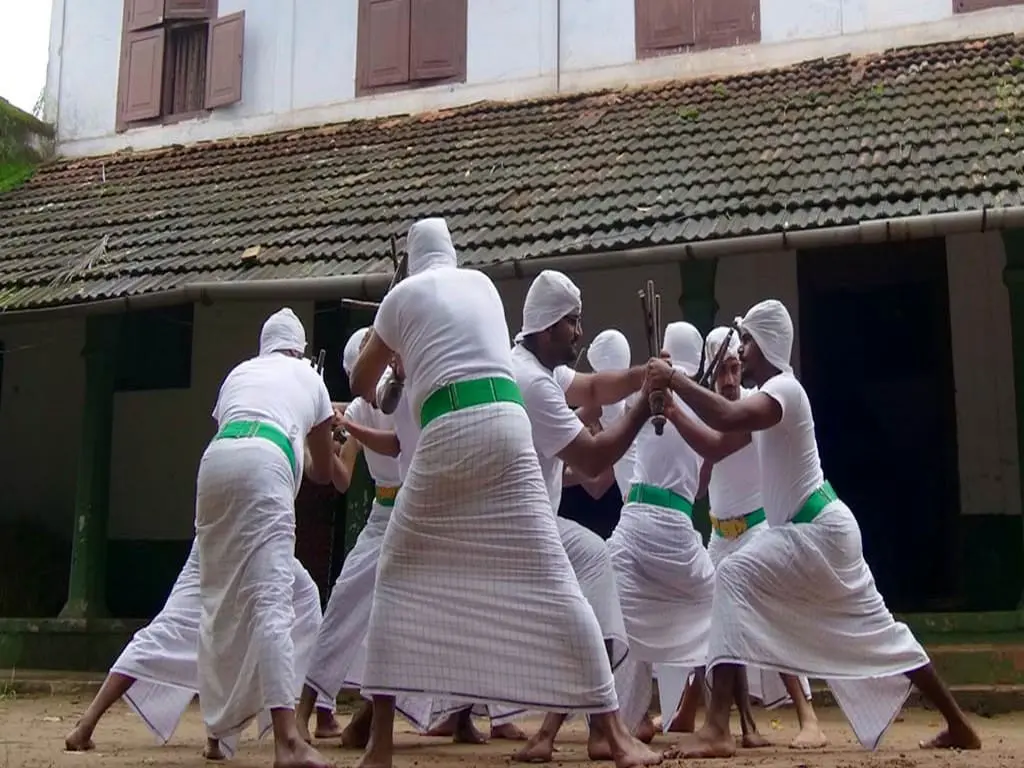
The dancers move along in circles around a ceremonial lamp. It is a rhythmic dance form that you can witness in villages and along the north Malabar region in Kerala. Owing to its perfectly coordinated movements, traditional music, and the constant rhythm of clapping wooden sticks, Kolkali is among the most spectacular Kerala dance forms to witness!
Where to watch Kolkali in Kerala:
- Kerala State School Kalolsavam (a major annual youth competition in Kerala)
- Theaters and cultural centers in North Malabar region
Kolkali songs explain tales of regional Gods
5. Ottamthullal
Originating in the 18th century, Ottamthullal, or simply Thullal, has become a popular Kerala dance form. Decked in vibrant costumes and loud make-up, dancers perform Ottamthullal with fluid hand movements and deliberate eye movements as a form of expression to narrate stories of Indian mythology.
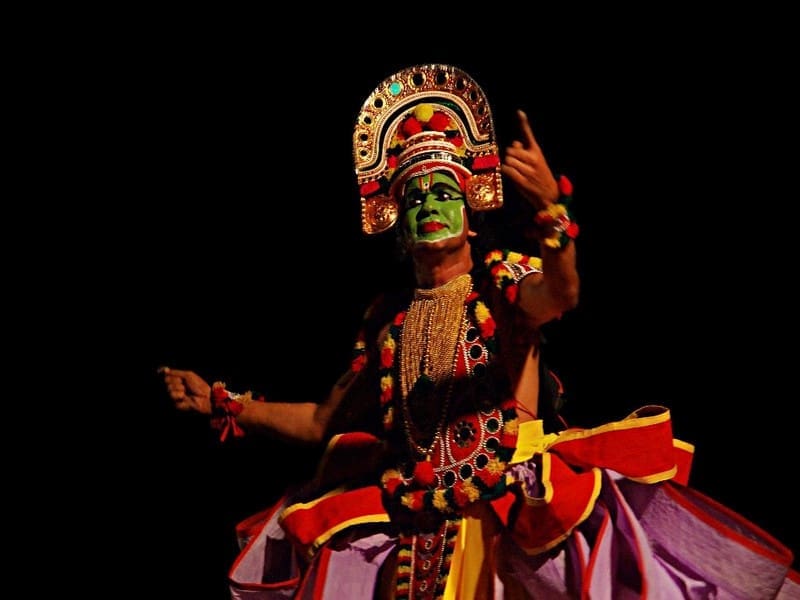
It is said that the famous Malayalam poet, Kalakkaththu Kunchan Nambiar, created this dance form. In some parts of Kerala, it is also called the “poor man’s Kathakali”! Thullal being a semi-stylized dance-theatre-narrative is performed in many parts of Kerala as musical skits/plays to highlight social issues, or used as a tool to narrate comedic tales. It’s also among the famous dances of Kerala festivals and religious events.
Where to watch Ottamthullal in Kerala:
- Kerala Kalamandalam, Thrissur
- Kerala Kathakali Centre, Kochi
- Vadakkumnathan Temple Koothambalam, Thrissur
Ottamthullal performances are satirical and portray prevalent socio-political injustices and prejudices of society
ALSO SEE – Onam Festival 2024-Celebrations and the Legend of Mahabali
6. Koodiyattam
Koodiyattam, or Kutiyattam, is a form of Sanskrit theater that means ‘combined acting’. It is a popular dance form in Kerala performed mostly in temples. This dance form involves many musical instruments that are also elements of Kuzhitalam, Conch, Kurumkuzhal, and Mizhavu. It’s famous for being one of the earliest Kerala dance forms, and since its recognition it has been performed in numerous temples across Kerala.
It takes actors and dancers 10-15 years of rigorous training to become fluent in performing Koodiyattam. Performers master the art of sophisticated breathing control and precise muscle shifts of the face and body to elaborately depict an episode or saga in detail, with a single act often lasting up to 40 days!
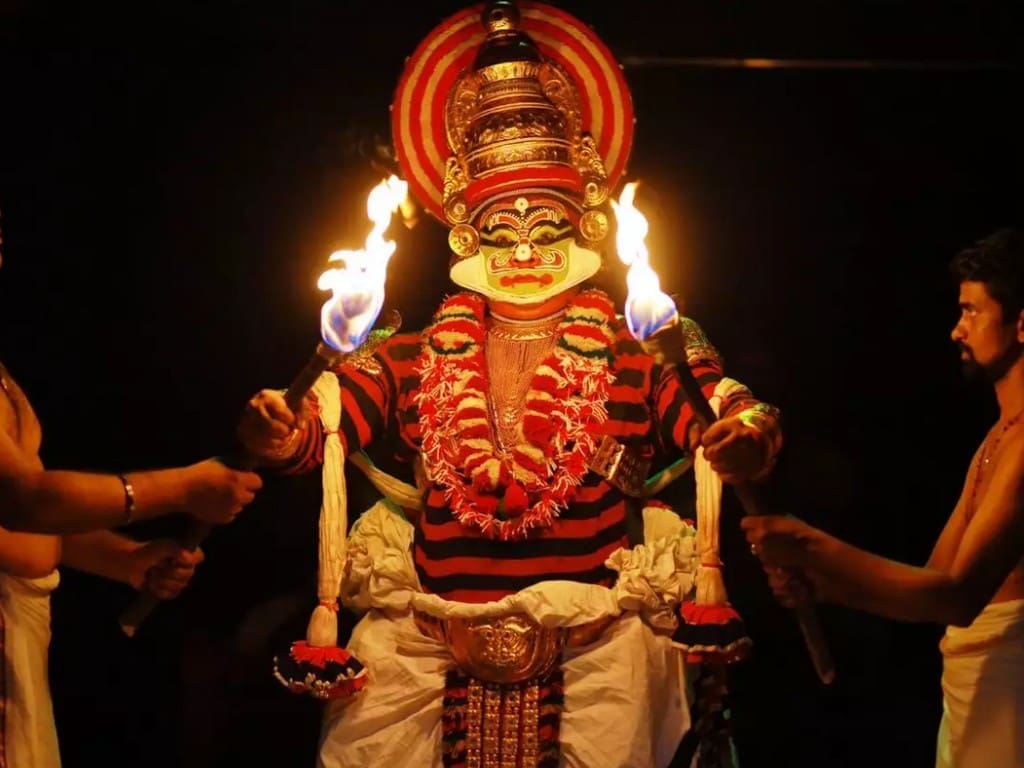
Kutiyattam is one of the oldest living theatrical traditions of Kerala. In earlier days, it was performed by the Chakkiyars and the Nangiars as a combined dance drama. The Chakkiyars played the male cast and the latter played the female cast. Sadly, it is now a dying art and can only be witnessed in select places across Kerala.
Where to watch Koodiyattam in Kerala:
- Kerala Kalamandalam, Thrissur
- Margi Theatre, Trivandrum
Kutiyattam dance act can last from six to forty days based on the stories of Hindu mythology it is used to depict
7. Chakyar Koothu
An ancient Kerala dance form, Chakyar Koothu was introduced by the early Aryans. It is an orthodox type of performance that is performed by the Chakyar caste. Often performed at temples or inside a special theatre known as the Koothambalam, this particular dance form is more of a type of highly elaborated monologue as opposed to a ‘dance’!

In Chakyar Koothu, a story is depicted from Indian epics like the Ramayana, the Mahabharata, and the Puranas through fluid body movements, swift gestures, practiced expressions, and sometimes even dialogues. Some even call it a traditional form of stand-up comedy act where, at times, the performers even ‘roast’ audience members lightheartedly for their entertainment and amusement.
Where to watch Chakyar Koothu in Kerala:
- Sree Peralassery Temple, Peralassery
- Vadakkumnathan Temple Koothambalam, Thrissur
- Margi Theatre, Trivandrum
Chakyar Koothu often incorporates comical acts to comment on socio-political issues using body movements and facial expressions
8. Oppana
Oppana dance form is specifically performed in the Muslim community of Kerala. The Oppana dance form is an essential part of wedding ceremonies and festivities of the Muslim community, especially in the Malabar region of Kerala. It is usually performed by a group of female relatives of the bride who sing and dance around the bride while she gets ready.
It’s one of the liveliest Kerala traditional dances and involves singing, clapping hands, and moving around the bride playfully teasing her on the eve of her marriage. Girls and musicians usually sing the traditional folksong of Mappila Pattu during this ceremony.
Where to watch Oppana in Kerala:
- Kerala State School Kalolsavam (a major annual youth competition in Kerala)
- Cochin Cultural Centre, Kochi
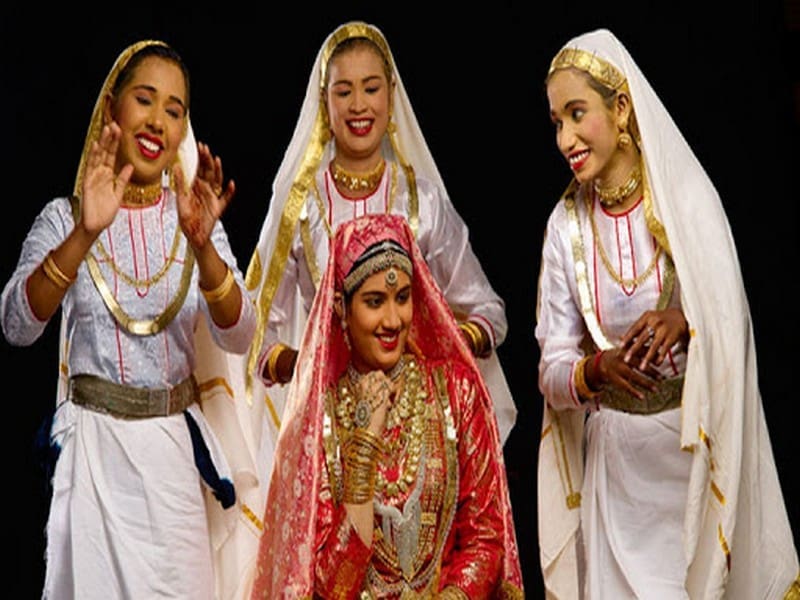
ALSO SEE- Best Places to Visit in North Kerala
9. Margamkali
One of the most ancient Kerala dance forms, Margamkali is popular among the Syrian Christians of Kerala. It is performed by women on festivals and important occasions, especially during wedding ceremonies. The dance is performed by a group of 12 women who dance in circles around a lighted oil lamp that signifies Christ where the dancers play the role of His disciples.
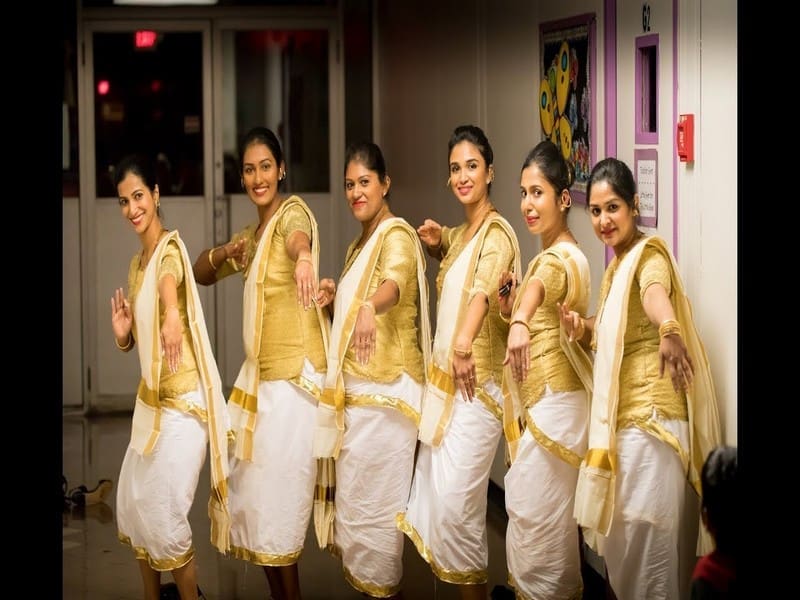
Margamkali is performed by Christian women who sing and dance in praise of Jesus Christ with brisk actions and quick movements to songs older than the Portuguese invasion! The women dance around a Nilavilakku wearing traditional Christian attire consisting of a Chatta (jacket), a traditional white Mundu (dress), and rich jewelry. It essentially depicts the arrival and life of St, Thomas in Malabar.
Where to watch Margamkali in Kerala:
- Cochin Cultural Center, Kochi
- Events organised by Kerala Folklore Academy, Kannur
In recent times, women enact the Margamkali dance while earlier it was predominantly performed by men
10. Theyyam
Theyyam is a famed ritualistic dance form of the Gods that is popular in the Malabar region of Kerala. There are about 456 types of Theyyam dance forms in Kerala and some of the most famous ones include Sree Muthappan Theyyam, Gulikan, Kathivanur Veeran, and Manakkott Amma.
It is a captivating amalgamation of dance, mime, and music used to breathe life into the epic tales and folklore of Kerala! Performed by ancient tribals centuries ago, it has survived the test of time and become an integral part of Kerala’s art and heritage, illustrating the importance of worshipping the spirits of ancestors and heroes!
Where to watch Theyyam in Kerala:
- Rhythms Theatre, Kochi
- Muchilot Bhagavathy Temple, Kannur
- Mallom Kollom Temple, Kasargod
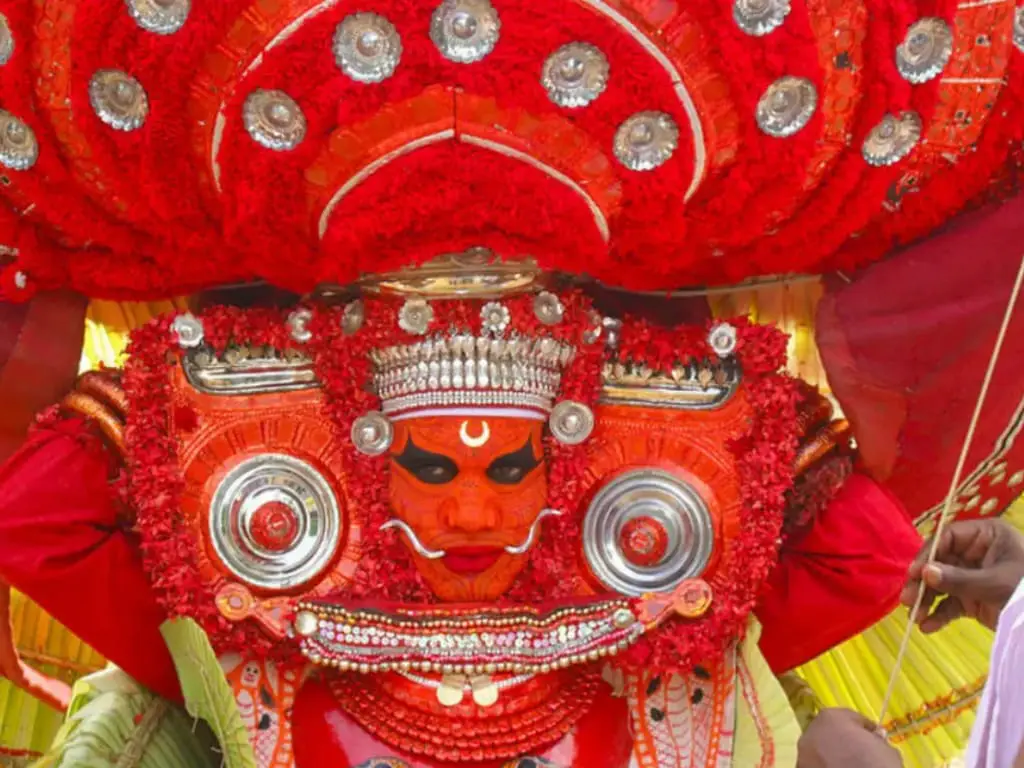
ALSO SEE – Theyyam, The Dance of the Gods
Kerala has about 50 forms of traditional dances, but we listed out the best Kerala dance forms that you must witness on your summer holiday in this southern state! Make sure you make a list of your favorite dance forms to see on your Kerala trip once you have read about each of them, their specialty, origin, and the way of expression that is unique to each dance form. Have questions? Reach out to us in the comments section below.
Hope you have a wonderful holiday in Kerala while you experience its art and culture!
Frequently Asked Questions About Kerala Dance Forms
Which is the most popular dance in Kerala?
Kathakali – A South Indian dance-drama originating in Kerala is among the most popular Kerala dance forms. Kathakali is an impressive form of classical dance that came into being more than 500 years ago in the southern state of Kerala. Kathakali is usually performed by men with colorful attire and face paint to depict tales of ancient epics and legends using face and eye movement.
Which dance has its origin in Kerala India?
Theyyam, Thiruvathirakali, Chakyar Koothu, Koodiyattam, and Ottamthullal are some of the famous dance forms in Kerala that originated in the state itself. Kerala is also popular for its two classical dance forms ‘Kathakali’ and ‘Mohiniyattam,’ which lure tourists from around the globe.
Which is the famous classical dance of Kerala?
Kathakali is among the most famous Kerala traditional dances. It is a combination of classical dance, theater, opera, and pantomime, a mixture of which makes Kathakali a truly vibrant and unforgettable Keralan art form. Kathakali is one of the most famous dance forms not only in Kerala but also in India.
How many folk dances are there in Kerala?
There are more than fifty well-known folk dances in Kerala. Some popular folk dances like Kathakali and Mohiniyattam are recognized as classical dances. Padayani, Kaikottikali, and Thirayattam are also the most popular folk dances of Kerala.
Is Kathak and Kathakali same?
No, Kathak and Kathakali are two very different dance forms originating in India. Both are part of the ten Indian Classical Dances and highly revered forms of art in the country. While Kathakali has its origins in southern India, predominantly Kerala, Kathak is said to have originated in the state of Uttar Pradesh in the north. Owing to the similarity in their names, people often confuse one with another or end up believing they are the same.
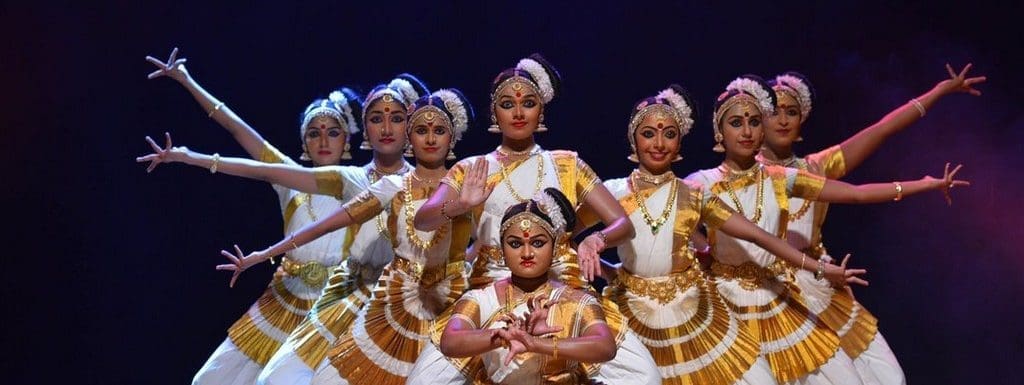
Thanks for the information.
thank you so much give explanation